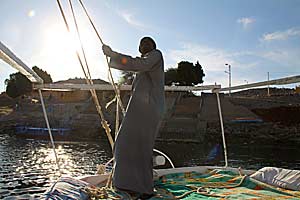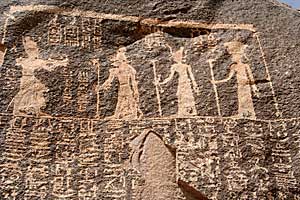

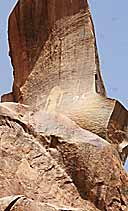 A
large island between Elephantine / Aswan and the Old Dam is called Seheyl
or Sahel or Sehel, or as the Egyptians say: Shellal. Before the dams were
built, the Nile would rush noisily through the granite boulders forming the
first Cataract. Today the water is slow, at some places the water is forming
circles around stones below the water.
A
large island between Elephantine / Aswan and the Old Dam is called Seheyl
or Sahel or Sehel, or as the Egyptians say: Shellal. Before the dams were
built, the Nile would rush noisily through the granite boulders forming the
first Cataract. Today the water is slow, at some places the water is forming
circles around stones below the water.
On this island is a cliff with more than 200 inscriptions, some 3.500 years old, made by princes, generals or other officials who passed on their journey to Nubia.
The most famous is the "famine stele" (2.667 - 2684 BC - broken stone on the picture on top and big photo left). More informations plese see in Lonely Planet or other guide books.
Martin and Linda Beavis sent us this wonderful description about their excursion (thank you!)
Among other things archaeological, we particularly wanted to visit Sahel and see the ancient inscriptions on the rocks, but were disappointingly told that, despite a good breeze, we should do that upstream trip by motor boat. But, having seen your website and read about you on Trip Advisor, we phoned Mustafa to arrange a felucca instead -- no problem! He came early to the hotel, checked what we wished to see and do, and we had a great trip on his new ("only secondhand") felucca, tacking up the Nile, seeing lots of birdlife, alongside the sweeping desert sands and into the rocks and swirling waters of the First Cataract.
That really is the best way to enjoy the Nile -- in your own felucca, at your own speed. We had not travelled all that way back to Aswan to be packed in like sardines singing ee-i-ee-i-ee-i-oh on a quick trip round Kitchener Island, especially not wearing the red lifejackets that one British tour operator insists on! (Been there, done that, got the photo -- not uploaded!)
Mustafa offered us the opportunity
to stop at the beach or visit a small camel market, before stopping at
a Nubian
village and then sailing between the islands around to the other side of Sahel,
to be closer to the rock inscriptions (more sailing, less walking!).
Like the Tombs of the Nobles that we visited on another occasion (and
well
worth seeing) they are not
much visited, so we woke up the guardians and set off up the hill. The most
must-see stela is at the very highest point of the island, as are the
fantastic views over the river to the north and the village to the south.
Back on the felucca, hot and dusty from our ascent of Sahel, we enjoyed refreshing mint teas in the shade of the canopy as we sailed back to Elephantine.
One felucca
each hour
13 USD
Optional -
with lunch:
19 USD each person
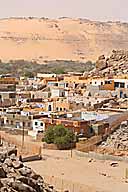
If no wind to sail:
• Motorboat to tear the felucca against the current near the Dam
and then sail back quietly (without motorboat) with the current (relaxing and beautiful):
felucca each hour
13 USD
plus 1x 14 USD for the motorboat
or
• Motorboat only
- if no wind:
cheaper than felucca plus motorboat
(but motorboat is loud, felucca is quiet)
- if you want to see much within short time (motorboat is faster than the felucca)
each hour 14 USD
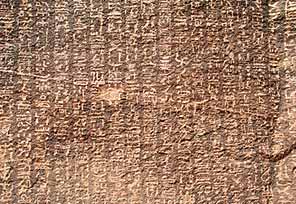





Picture above: Djoser offering gifts to Chnum, Anuket and Satis
Starving steel
Approximately 200 years B.C. the priests of Elephantine were falsifying history: they scratched an inscription, according to which the Pharaoh Djoser (2.700 B.C.) gave all conquered Nubian regions to Khnum, the guardian god of Nile flood, in order to dispel the famine that had haunted Egypt for 7 years by then.
"My heart was heavy because the Nile had not come for years during my time. The corn thrived sparse, seeds withered in the ground and there was not enough food (...) But I turned away from the grief and called for the top lector priest Imhotep. (...) While I was sleeping, the god appeared to me and said, I am Khnum, who has created you (...) The hearts of the Egyptians will cheer for joy more than ever. (...) Then I awoke. (...) As soon as I had collected my thoughts, I issued a decree in favor of my father Khnum. "
("Read in: Bildlexikon der Völker und Kulturen, Band 7")
